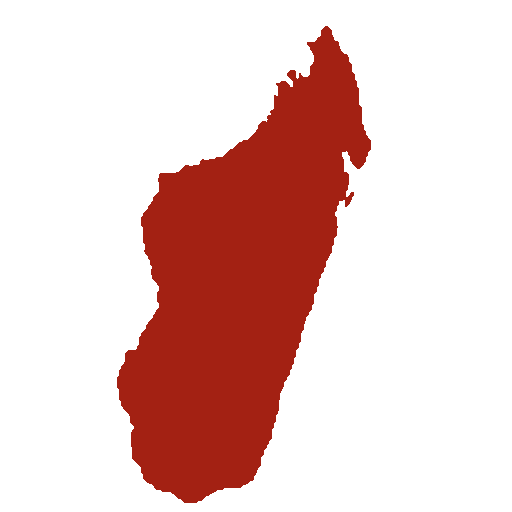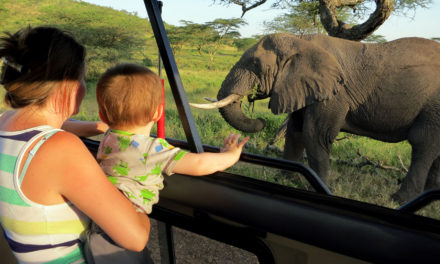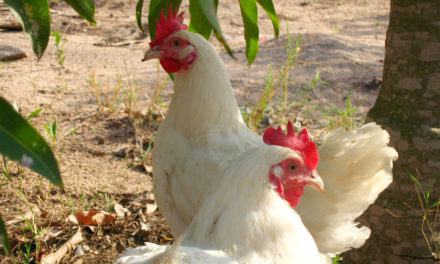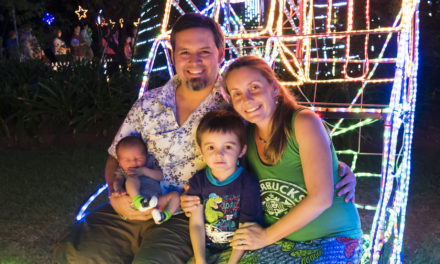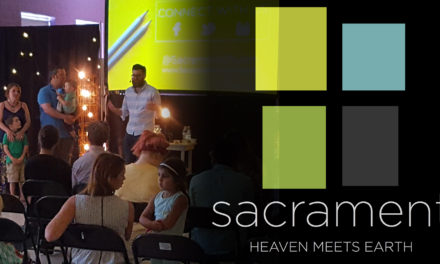T he storm hit us out of nowhere. One minute it was sunny and cloudy, the next we could barely see 20 feet in front of us as the rain poured down from all directions. The waves rose 10 feet around us and the boat crashed into one wave and then went rushing down the next, all crowded together with no time for us to choose the angle for hitting them. The boat driver desperately wiped the water from his face as he tried to see well enough to keep the boat on track, to keep the waves from pushing us sideways and maybe from pushing us over. I sat up near the front, the crashing waves and the rain drenching me to the bone, trying to make sense of the GPS readout and give hand signals to the driver just so he’d know which direction is which. It’s called a “mantasaly,” these sudden afternoon ocean storms, and we were right in the middle of a bad one, still 10 miles from land, our final destination.
A few days before, Lora and I were just antsy to get back to Nosy Mitsio. It had been weeks that we were away in Diego, the northernmost city in Madagascar. A trip that should’ve been just a few days to consider buying a boat for our team kept stretching on and on for over a month; deadlines and dates kept getting pushed back just a few more days and then a few more again. Here in Madagascar it’s always “hurry up and wait.” I was also anxious to leave before Madagascar’s rainy season got into full swing, which could make the trip much worse for us. We had a narrow window of opportunity, but most of the timing wasn’t working in our favor.
Then finally the boat was finished, the motors were there and had both been taken on a test run, and the two boat drivers had finished up their family obligations (they’re fishermen on the northwest coast of Madagascar, who sometimes stay on Nosy Mitsio). It was time to go! And then another morning started off with bad rain and winds, so we waited again. More of the same during Madagascar’s rainy season.
But the next morning we caught a break in the weather – the wind slowed to nearly nothing even if rain was still on the horizon. The boat drivers and I left before it could turn bad again. Lora and Matimu took a taxi brousse back down to the town closest to Nosy Mitsio’s port village – no reason for them to endure a few days on the ocean since only one of us was required to accompany the boat. I was very glad to have finally left, but hesitant about the trip ahead: we’d have to round the tip of Madagascar and work our way down the northwest coast, two days to Nosy Mitsio, and then one more trip back to the port village where I’d meet up with Lora and Matimu again. The trip turned out to be 125 miles total – nothing at all in a car over paved roads, but something altogether different in a little wooden boat being tossed around by the ocean.
Thankfully, the trip started out great. We got out of Diego’s harbor in time to escape the rain and we caught quite a few fish in just the first few hours, by trolling a couple fishing lines behind us as we went. When rounding the northern tip of Madagascar with no protection from any other bodies of land, we ran into some huge waves, some of them easily 10 feet high. But the waves were spread well apart and our boat just climbed and descended them one after another, bumpy but not scary. Unfortunately for our boat drivers’ wives who accompanied us on the trip, they didn’t handle it so well and were vomiting out the sides of the boat for quite a while.
Not long after, we got caught in a straight downpour and our boat’s recently constructed roof came in very handy, protecting us from being soaked as we fixed sandwiches and ate them under the boat’s canopy. The women didn’t have an appetite, but I was feeling a sense of adventure: rain falling around us, our new boat on its way to Nosy Mitsio at last, fresh-caught fish lying in the hull, and me sitting mostly dry and eating lunch. The rain didn’t last long and we started working our way down southwest, catching more fish along the way.
In the late afternoon, we made it to a small village on the coast where our boat driver fishermen also stay sometimes depending on the season. We arrived just in time to get soaked by another downpour blowing in from the front – the boat’s canopy unable to help us this time. But we were at a stopping point for the day and we trudged up through the mud to the village, to the house of one of their friends. There we received a very warm welcome. I’m often amazed at how great Malagasy hospitality can be! I didn’t bring a change of clothes (at least none that were still dry after the day’s trip) and our hosts loaned me, someone they’ve never met before, some dry clothes to use for the evening. Maybe this doesn’t seem like a big deal for us Westerners whose closets are always full, but most rural Malagasy people have no more than 2 or 3 changes of clothes altogether, so I recognized how generous they were being.
We all spent the evening in conversation, warming up and drying out under the roof of our hosts’ cooking hut, where we grilled and fried up the day’s catches, all 27 kg (60 pounds) of it! I had some albacore steaks grilled with lime from a tree in their village and it was some of the best fish I’ve ever had, though I’m sure the long day on the ocean would’ve made anything taste great. They explained to me some of the differences and similarities of the local tribal groups as well as the interesting fact that most people who move to town stop obeying most of their tribal taboos. Then our hosts in the village fixed up some temporary walls on a small half-finished hut and all five of us crammed in on a single foam mattress for the night. It was all better than I expected for my first evening’s accommodations and I slept pretty well.
W e were up early again the next morning, just before sunrise, and we left the village in a light misty rain. The sea was fairly calm but the rain continued to pick up throughout the day and blew right into the boat underneath our canopy. We were cold and wet all day long and it wasn’t feeling as much like an adventure anymore; I was just ready to get it over with. I guided the boat with my GPS when the rain got too heavy to see land, and everyone was thankful that it’s waterproof. We all knew that we should reach Nosy Mitsio that day, so our hopes were still high despite the rain. We passed by a group of small islands that were some of the most interesting I’ve ever seen, but I couldn’t get a photo with all the rain pouring down. From there it was over the open ocean again and just a few more hours to Nosy Mitsio!
We arrived even earlier than expected and were warmly greeted by our few neighbors in our small village. They shared their news and we shared ours, and they expressed their disappointment that we weren’t there for the New Year’s festivities. But with plenty more fish to share from the day’s boating, their disappointment didn’t last long! I was also happy to be the one to provide the hospitality this time around and get everyone settled down in our warm house with comfortable beds. We only stayed the one night though, because we had to be off again the next day to meet Lora and Matimu on the mainland.
We were all anxious to see how the trip from Nosy Mitsio to Port St Louis would go in the new boat with the new motor. In all our other trips along that path, our experiences have varied wildly – anywhere from 3-4 hours with a good boat and motor, to 15 hours with a broken motor and no winds, just drifting around in the sea, waiting for a way to get back to land, either by sailing or paddling. We were hoping this trip with the new boat and stronger motor would be under two hours, and we have a back-up motor in case anything ever happens to the primary one while out at sea.
S o when we left Nosy Mitsio around noon the next day, trying to time our entry to the port along with the high tides, we had nothing to worry about. The skies were partly cloudy and the sea was no rougher than normal. Because of the west wind that’s common during this time of year and which causes the waves to be too high and break too much on our side of the island, we had to move the boat to the east side and load up there, but that seemed to be a minor inconvenience. When we got an hour out to sea, nearly to the halfway point already, we saw what looked like a little rain coming up behind us. We started preparing the canopy and passed a rain jacket to the boat driver. But within just a couple of minutes, before we could get anything tied down, it was already on us and in full force – a “mantasaly”!
The waves were high and fast, one after another, doing their best to push our boat sideways, and the rain was pouring hard enough we could barely see more than two or three waves at a time. Every time the boat did get pushed sideways, there was a slight pause and the driver was able to straighten it out again. But one time we got pushed sideways and then immediately were hit by another wave, much of it crashing right down into the boat. I thought that if we got hit by a third wave while still sideways, it might be the end of it. But we had time to straighten out the boat, it didn’t happen again, and after what seemed like an eternity later (about 30 or 45 minutes), the storm was gone as quickly as it came. The rain stopped and the waves died back down. We made it to the port more than a little shaken up, but we were safely on land again. Despite the awful storm, the whole trip only took about 2 ½ hours. Our boat driver said that if it weren’t for my GPS we would’ve been lost for sure, and if we were running on a motor anything weaker than what it was, we probably wouldn’t have made it.
T he funny thing is, during the rougher parts of our three-day trip and especially during that sudden “mantasaly”, I wasn’t thinking about much of anything at all and I wasn’t even particularly afraid. It wasn’t like the first big storm we were caught in since moving to Nosy Mitsio. By comparison, that first storm was pretty tame, but I remember at the time that I was pretty well frightened and praying fervently for God’s protection. This time I recognized the challenge we were facing and realized the serious danger it posed, but my internal response to it was altogether different. Maybe it had a little to do with the dozen or more trips we’ve taken over that stretch of the ocean already, maybe I was just beginning to get used to it all. But I think it had more to do with a simple recognition of the company I was standing in, of those who’ve gone before me, following God’s call across rough seas and being miraculously carried along (shipwrecked or not) in order to get to the place God’s calling them, to share the message of his Kingdom come and of the King who has died on our behalf and who has risen again.
Anyone who is familiar with the Bible knows that it’s full of stories of God’s people out on boats in the middle of stormy seas. One of the earliest stories in the Bible is of Noah and the simple message that what God has planned, he’ll make it come to pass, no matter how rough things get in the meantime, and no matter how wayward men’s hearts are. And of course there’s plenty more stories like his, men tossed around at sea, but God guiding them faithfully to their destination. But I’ve been thinking mostly about Paul and his little crew.
The last couple chapters of Acts are action-packed and filled with the story of Paul’s and Luke’s adventurous ocean journey from Caesarea near Jerusalem all the way to Rome. I can identify with so much of it now: travelling along the coast for multiple days, stopping at one port or another, contrary winds keeping you from getting where you want to go, and finally getting the right wind and giving it a shot. I like the way Acts 27:8 is written in The Voice translation: “Sailing conditions were adverse to say the least.” Or verse 9, “We had lost a lot of time already… and conditions had deteriorated from adverse to dangerous.” Luke also writes about a boat owner who thinks he can make the trip anyway, despite advice to the contrary. Wait a minute, I think I’ve been on that same boat with that same boat owner! Haha! So they set out and get caught by a violent northeasterly wind – I know I’ve been in that situation before.
The story continues with what I believe really is one of the most exciting and suspenseful passages in the Bible. Thankfully, I can’t quite relate to most of the rest of it. I haven’t yet been in a single storm that lasted for weeks, only to be thrown from the boat grasping desperately at its wreckage, and I hope that never happens. But I know what it’s like to arrive at an unknown beach in the rain and the cold and to be greeted with warm hospitality. All around it’s an incredible story.
D espite the storms that batter and destroy, despite our weak and helpless state compared to all the forces around us, God will keep us on his path. We just need to keep faith in him. His path doesn’t always take us where we expect to go, but he’s always going ahead of us and working even when we don’t know it – wonderful things that demonstrate his sovereignty and his grace. I think he really put that idea strongly in me when we were caught by the “mantasaly”. At the time, all I could really think about was that both the ocean and the storm was God’s and he’ll take me where he wants me to go, just like he did with Paul and Luke.
Lora and I (and I’m sure also our team) want to thank all of you for being part of this adventure with us! So many of you have blessed us so incredibly, with your prayers, with your words of encouragement, your care packages in the mail, and with your exceedingly generous giving towards our work here and towards our team boat. You’ve provided even more than we need for our share of the boat and we’ll put the extra towards our portion of the operating costs that we’ll be covering in the meantime.
Since this three-day adventure, I’ve been piloting the boat myself (with our boat driver with us to coach me or take over in a tight spot) and I’m getting the hang of it pretty well and starting to recognize our local weather patterns during this season. I’ve already driven the trip to and from Nosy Mitsio and also several trips around Nosy Mitsio to pick up and deliver building materials (thankfully fairly calm weather most of the time). The construction of our team members’ homes is moving forward well again and it’s thanks to your help in providing this transport. I don’t think we can thank you enough, but we want you to know that you’ve helped to provide safety and security and the means to more easily and fully follow God where he’s leading us. I don’t know what would’ve happened in the “mantasaly” if we didn’t have that strong motor that was purchased for the boat, but many of you helped provide that and it got us safely through the storm so we’re forever grateful. We pray that God’s blessings are also evident to all of you in this new year, and that despite any rough seas or storms you face along the way, that you’ll keep your faith in him as he carries you along his path.
In Christ,
Adam, Lora, and Matimu
